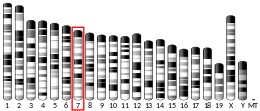
Back عامل نمو الخلايا الليفية 21 Arabic عامل نمو الخلايا الليفيه 21 ARZ FGF21 Spanish فاکتور ۲۱ رشد فیبروبلاست Persian FGF21 French FGF21 Italian FGF21 Ukrainian
Fibroblast growth factor 21 (FGF-21) is a protein that in mammals is encoded by the FGF21 gene.[5][6] The protein encoded by this gene is a member of the fibroblast growth factor (FGF) family and specifically a member of the endocrine subfamily which includes FGF23 and FGF15/19. FGF21 is the primary endogenous agonist of the FGF21 receptor, which is composed of the co-receptors FGF receptor 1 and β-Klotho.[7]
FGF family members possess broad mitogenic and cell survival activities and are involved in a variety of biological processes including embryonic development, cell growth, morphogenesis, tissue repair, tumor growth and invasion.[6] FGFs act through a family of four FGF receptors. Binding is complicated and requires both interaction of the FGF molecule with an FGF receptor and binding to heparin through a heparin binding domain. Endocrine FGFs lack a heparin binding domain and thus can be released into the circulation.
FGF21 is a hepatokine – i.e., a hormone secreted by the liver – that regulates simple sugar intake and preferences for sweet foods via signaling through FGF21 receptors in the paraventricular nucleus of the hypothalamus and correlates with reduced dopamine neurotransmission within the nucleus accumbens.[8][9][10]
A single-nucleotide polymorphism of the FGF21 gene – the FGF21 rs838133 variant (frequency 44.7%) – has been identified as a genetic mechanism responsible for the sweet tooth behavioral phenotype, a trait associated with cravings for sweets and high sugar consumption, in both humans and mice.[11][12][13]
- ^ a b c GRCh38: Ensembl release 89: ENSG00000105550 – Ensembl, May 2017
- ^ a b c GRCm38: Ensembl release 89: ENSMUSG00000030827 – Ensembl, May 2017
- ^ "Human PubMed Reference:". National Center for Biotechnology Information, U.S. National Library of Medicine.
- ^ "Mouse PubMed Reference:". National Center for Biotechnology Information, U.S. National Library of Medicine.
- ^ Nishimura T, Nakatake Y, Konishi M, Itoh N (June 2000). "Identification of a novel FGF, FGF-21, preferentially expressed in the liver". Biochimica et Biophysica Acta (BBA) - Gene Structure and Expression. 1492 (1): 203–6. doi:10.1016/S0167-4781(00)00067-1. PMID 10858549.
- ^ a b "Entrez Gene: FGF21 fibroblast growth factor 21".
- ^ BonDurant LD, Potthoff MJ (May 2018). "Fibroblast Growth Factor 21: A Versatile Regulator of Metabolic Homeostasis". Annu Rev Nutr. 38: 173–196. doi:10.1146/annurev-nutr-071816-064800. PMC 6964258. PMID 29727594.
- ^ von Holstein-Rathlou S, BonDurant LD, Peltekian L, Naber MC, Yin TC, Claflin KE, Urizar AI, Madsen AN, Ratner C, Holst B, Karstoft K, Vandenbeuch A, Anderson CB, Cassell MD, Thompson AP, Solomon TP, Rahmouni K, Kinnamon SC, Pieper AA, Gillum MP, Potthoff MJ (February 2016). "FGF21 Mediates Endocrine Control of Simple Sugar Intake and Sweet Taste Preference by the Liver". Cell Metabolism. 23 (2): 335–43. doi:10.1016/j.cmet.2015.12.003. PMC 4756759. PMID 26724858.
- ^ Talukdar S, Owen BM, Song P, Hernandez G, Zhang Y, Zhou Y, Scott WT, Paratala B, Turner T, Smith A, Bernardo B, Müller CP, Tang H, Mangelsdorf DJ, Goodwin B, Kliewer SA (February 2016). "FGF21 Regulates Sweet and Alcohol Preference". Cell Metabolism. 23 (2): 344–9. doi:10.1016/j.cmet.2015.12.008. PMC 4749404. PMID 26724861.
- ^ Søberg S, Sandholt CH, Jespersen NZ, Toft U, Madsen AL, von Holstein-Rathlou S, Grevengoed TJ, Christensen KB, Bredie WL, Potthoff MJ, Solomon TP, Scheele C, Linneberg A, Jørgensen T, Pedersen O, Hansen T, Gillum MP, Grarup N (May 2017). "FGF21 Is a Sugar-Induced Hormone Associated with Sweet Intake and Preference in Humans". Cell Metabolism. 25 (5): 1045–1053.e6. doi:10.1016/j.cmet.2017.04.009. PMID 28467924.
- ^ Frayling TM, Beaumont RN, Jones SE, Yaghootkar H, Tuke MA, Ruth KS, Casanova F, West B, Locke J, Sharp S, Ji Y, Thompson W, Harrison J, Etheridge AS, Gallins PJ, Jima D, Wright F, Zhou Y, Innocenti F, Lindgren CM, Grarup N, Murray A, Freathy RM, Weedon MN, Tyrrell J, Wood AR (April 2018). "A Common Allele in FGF21 Associated with Sugar Intake Is Associated with Body Shape, Lower Total Body-Fat Percentage, and Higher Blood Pressure". Cell Reports. 23 (2): 327–336. doi:10.1016/j.celrep.2018.03.070. PMC 5912948. PMID 29641994.
- ^ Greenhill C (July 2017). "Liver: FGF21 - the cause of having a 'sweet tooth'?". Nature Reviews. Endocrinology. 13 (7): 378. doi:10.1038/nrendo.2017.62. PMID 28497814. S2CID 3906326.
- ^ Geach T (March 2016). "Neuroendocrinology: FGF21 influences a 'sweet tooth' in mice". Nature Reviews. Endocrinology. 12 (3): 123. doi:10.1038/nrendo.2016.8. PMID 26822924. S2CID 8239766.





